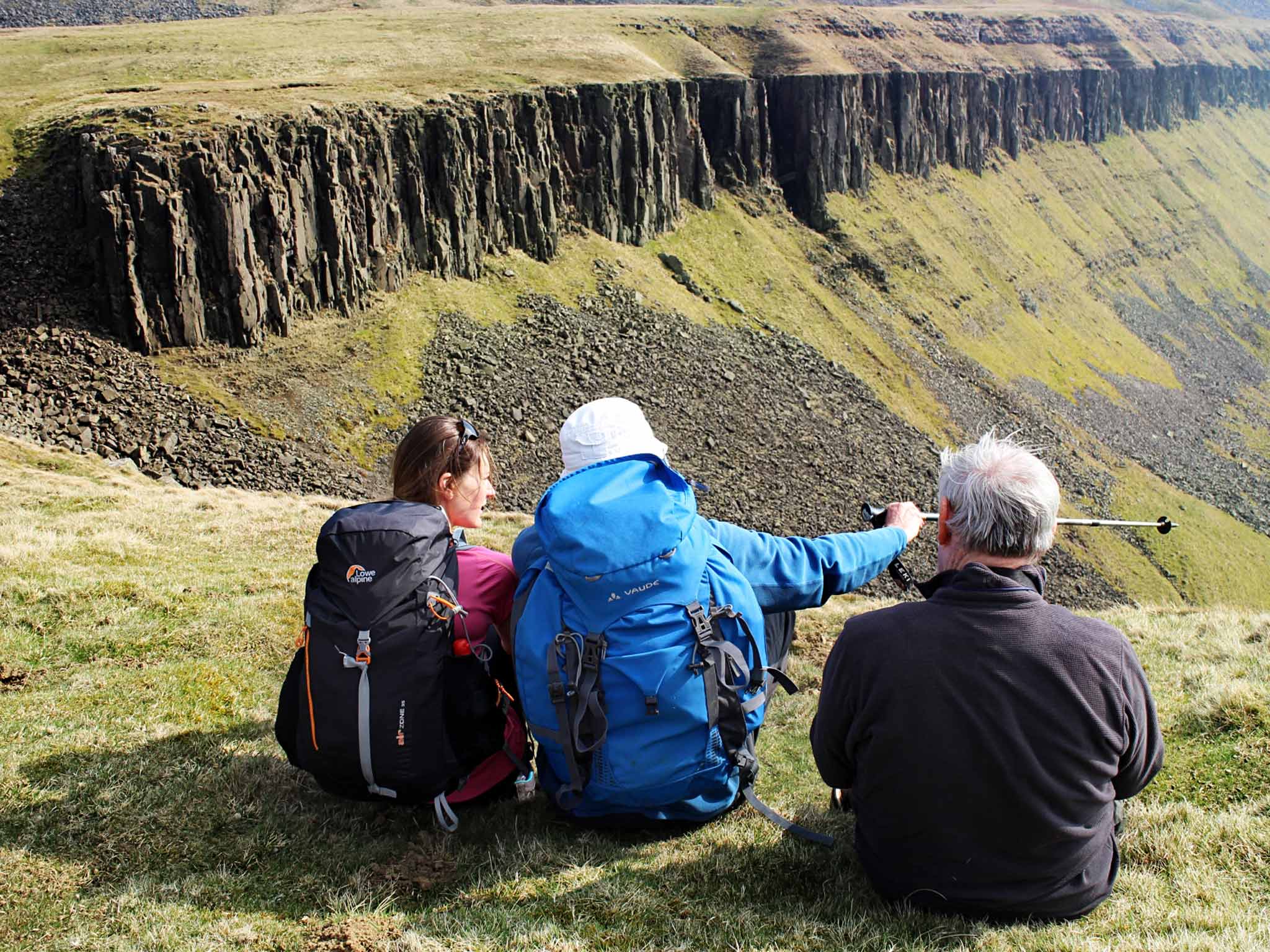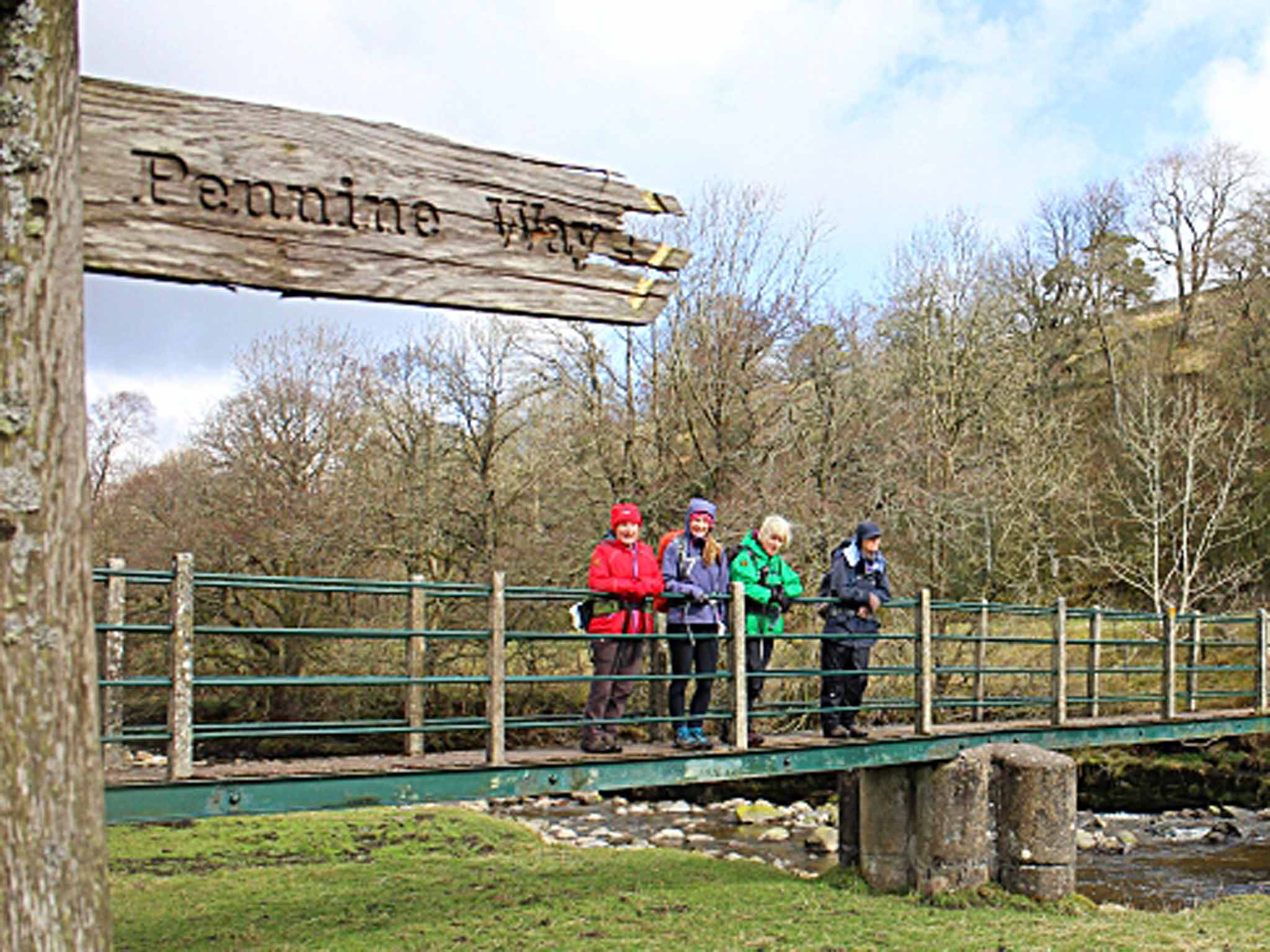The Independent's journalism is supported by our readers. When you purchase through links on our site, we may earn commission.
The Pennine Way at 50: Walking the Cumbrian leg from Langdon Beck to Alston
This week marks the 50th anniversary of Britain's oldest National Trail, the Pennine Way. Ellie Ross follows the acorn signposts up hill and down dale for a celebratory ramble

The afternoon sunlight is spilling in front of me, boring through my closed eyelids, as I inch towards the edge of a cliff. Gingerly, I place one foot in front of the other, feeling grassy clumps beneath my boots and resisting the urge to peep. A lapwing cries overhead, its song dancing on the wind that is blowing stronger with each step.
"It will be worth the wait," says Graham Allan, chairman of Penrith Ramblers Association, who is guiding me towards what he promises will be a highlight of the Pennine Way. "This is the best way to experience High Cup Nick for the first time. You wouldn't want to catch sight of it too early and ruin the surprise. Now, open your eyes."
A startling panorama comes into focus – rusty-coloured fells tumble into the verdant Eden Valley below, as though a great scoop has been taken from the face of the North Pennines. A steep band of blue-grey dolerite crags rims this great chasm, like a jagged line of sentries watching over the glaciated landscape.
I have walked five hours to reach this precipice, passing just a handful of other walkers as I near the end of my first day on the Pennine Way, Britain's oldest National Trail. Friday marks 50 years since the 268-mile route was launched, spawning another 14 long-distance walking, cycling and horse riding National Trails around the country.
The Pennine Way is the best known, and toughest, of the lot. It follows the mountainous "backbone of England", from Edale in the Derbyshire Peak District to Kirk Yetholm on the Scottish border. I am spending three days walking the Cumbrian leg, 34 miles starting in Langdon Beck in County Durham, to Alston.
I meet Graham just past the halfway point, at Langdon Beck Youth Hostel, which also celebrates its 50th anniversary this year. The beautiful stone building was built with its environment in mind and uses rainwater to flush loos, while a last-minute packed lunch request isn't too much trouble for the friendly staff.

"When the Pennine Way opened, people tended to walk the whole route in one go, as a challenge," says Graham, as I hoist on my backpack. "But that's not for everybody, and taking three weeks off to do it isn't always feasible. It can still be enjoyed in smaller sections, and this option attracts more than just hardened walkers."
Under a cloudless spring sky, we set off, heading for Dufton, an old lead mining village 13 miles away. After a quarter of a mile of ambling over flat pastures, we reach the first of many wooden signposts, imprinted with the National Trail's acorn symbol.
I clamber over a stone stile and walk past a field, where I notice a gruesome display of dozens of dead moles hanging from barbed wire. "That's the mole-catcher's way of showing he's worth his fee," Graham explains. "Moles can be a pest for farmers. If you're used to towns, you might think it's awful. But it's not controversial around here, it's part of country life."
We push on, following the gushing River Tees upstream, scrambling over a section of boulders and passing workmen re-laying limestone paving. In the Seventies, there were so many walkers on the Pennine Way that its peaty sections were churned up into porridge-like bogs. The problem was addressed by laying sections of flagstones from disused Lancashire Cotton Mills.
Rounding a bend in the river, I am suddenly confronted by a waterfall, the seething mass of Cauldron Snout, hissing and spewing spray into the turbulence downstream. Using my hands, I scale some chunky rock steps alongside it until I reach a stony path, which winds beside vast, grassy moorland used as a military firing range.
This area is peppered with "shake holes"– mini craters formed when limestone dissolves in rainwater. Rabbits hop in burrows dug into these cavities, but for walkers, they can be treacherous, especially in winter, when snow conceals the danger.
I cross a bridge over a gorge, pause for respite at High Cup Nick, then wend my way down into the Eden Valley, leaving behind fell ponies, grouse, frogs and pastures of grazing sheep and their newborn lambs. In Dufton, The Stag Inn is a good place to rest my aching feet by a log fire after a long day on the fells.
The next morning, the serious climbing begins as I hike up Cross Fell, the highest point in the Pennines. I am joined by Sue Tomlinson, a retired history teacher and keen walker, who lives near Penrith and first completed the Pennine Way in 1978.
"Any walker worth their salt would have walked the Pennine Way in the Seventies," she says, bounding uphill towards Cross Fell's 2,930ft summit. "But then new trails were introduced, which took some people away. It also gained a reputation for its bleak moorland and for being too gruelling."
Catching my breath as I reach a high plateau, I can see why. Ahead is a barren landscape of red-tinted grass, strewn with rocks and bogs, with almost indistinguishable paths. Yet there is beauty amid the bleakness. At the summit, I shelter from the wind behind a cairn, watching as the distant peaks bump their heads against the sky, through a hazy sheen.
It was an overcast day here that inspired JMW Turner to sketch Rain Clouds over Cross Fell in 1809. But on a clear day you can see the silvery Lakes, the west and east coasts and even as far as the Cheviots.
Having conquered the summit, it is downhill all the way to Garrigill, before the final four-mile push to The Cumberland Hotel in Alston. This quirky town of cobbled streets was visited by Dickens in 1838 as he researched Nicholas Nickleby, and has changed so little since that it was used as a location for the 1999 ITV mini-series of Oliver Twist.
The sun is still high as we descend, setting the flanks of the fells ablaze. Yet great swathes of snow remain on the northern slopes, sparkling like diamond dust in the light. Sue produces a plastic sheet from her rucksack and hands it to me. "I bet you didn't think you'd be sledding down Cross Fell on such a warm day," she says with a smile.
Moments later, I am sitting on my makeshift sledge, a snowy track beneath me and the rising peaks ahead. I push off, sliding feet-first down towards the next stage of the Pennine Way, a trail that keeps surprising, half a century on.
Getting there
The writer was a guest of Virgin Trains (0871 977 4222; virgintrains.co.uk), which serves Penrith from London Euston, Birmingham, Preston, Edinburgh and Glasgow. Advance fares from London start at £16.50 one-way.
Staying there
Langdon Beck Youth Hostel (01833 622 228; yha.org.uk/hostel/langdon-beck) has beds from £13 per night.
Dufton Youth Hostel (01768 351 236; yha.org.uk/hostel/dufton) has beds from £13 per night.
A double room with B&B at The Cumberland Hotel Alston (01434 381 875; alstoncumberlandhotel.co.uk) is from £80, with breakfast.
More information
Join our commenting forum
Join thought-provoking conversations, follow other Independent readers and see their replies
Comments
Bookmark popover
Removed from bookmarks